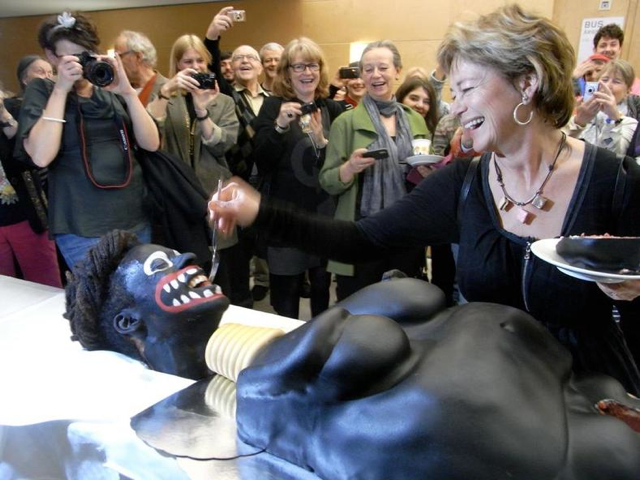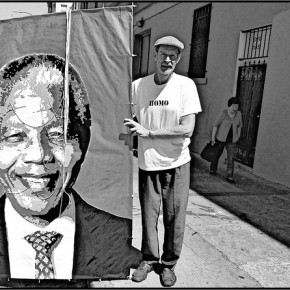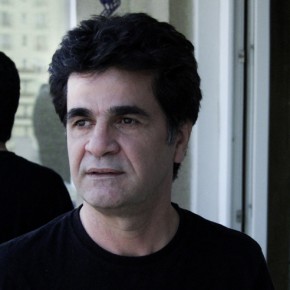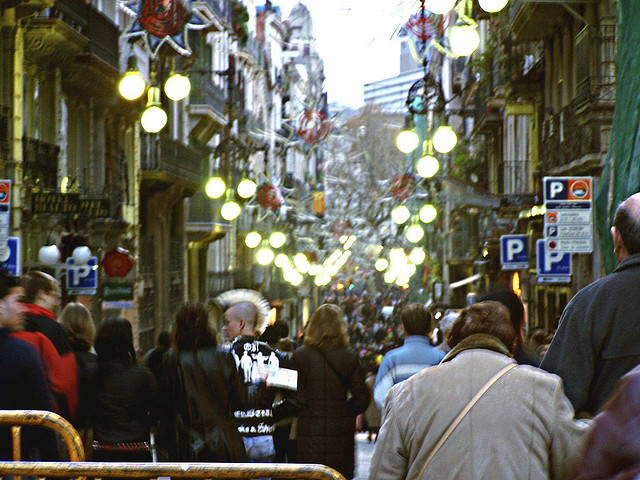By now, you may have heard about the “racist art cake” incident at an event celebrating the 75th birthday of the Swedish Artists Organization at the Moderna Museet. During the event, Swedish Culture Minister Lena Adelsohn Liljeroth was invited to cut the first piece of a cake designed by biracial African-Swedish artist Makode Aj Linde that was part of a five-cake installation.
The deep-black-frosted blood-red cake was shaped in a Venus-of-Willendorf-style caricature of an African woman’s body, with Linde’s head—his face made up in continental-African blackface–appearing through a hole in the table as the body’s living noggin, and screaming in agony with every slice.
The Swedes’ dark sense of humor being what it is, Liljeroth sliced away with aplomb starting at the crotch, surrounded by an all-white crowd of nervously laughing camera-armed admirers. She even fed a piece of her slice to Linde, who played right along. The rest is far too predictable. Photos and video of the bizarre proceedings made their way across The Network at light speed, outrage was unleashed, and Liljeroth was compelled to release a statement that explained her part in the matter.
Meanwhile, Linde has spent the past couple of weeks somewhat futilely explaining the cake piece in the context of his artistic vision and its social implications. In fact, he’s linked the piece to awareness about female genital mutilation (FGM). Now, Linde is more than a shock artist. He’s made a name for himself as Sweden’s best known African artist with Afromantics, his 8-year-long line of artworks that extend blackface caricature across the landscape of Western icons (a couple of examples here). And although he comes from a long conceptual line of stereotype-subverting diasporic African artists like Betye Saar and Kara Walker, Linde has generally infused his approach with some original ideas.
But as effective as Linde’s work has been up to this point, the cake piece has proven his limitations with regards representing concerns that aren’t directly related to him as a male. A bevy of black women online have analyzed the problems with the piece beyond the typical outrage. Blogger Tiff “Coffey” J put it most cogently:
I will say that the image of a man, in Minstrel makeup, portraying an African woman and victim of FGM as a caricature for a predominantly White audience, is unsettling. Particularly since his message of awareness seemed to be lost in translation amongst the sea of laughing and smiling European faces; none of which showed any semblance of concern about the intended message of Female Genital Mutilation or its effect on African women.
And as commenter Cade DeBois noted in her list of problematics with the piece on Feministe:
None of this seems to suggest *anyone* involved understands how genuinely painful, scarring and traumatic FGM can be for many women or how in some regions, women are forced to undergo FGM against their will and even violently, and too often without proper medical care afterwards, leading to infection, further pain and even death. Why would you think this is an appropriate way to address such an issue? What next? A rape victim cake?
Kenyan artist/activist Shailja Patel bottomlined it best:
Cui bono? Who benefits?
Linde has achieved overnight global fame from this exercise – the kind of exposure and media spotlight artists dream of. Sweden’s Culture Minister, Lena Adelsohn-Liljeroth has established herself as a champion of provocative art. It’s not clear how any woman who has had FGM, or any girl at risk of FGM, is materially better off.
Photograph courtesy of the Crunk Feminist Collective. Published under a Creative Commons license.




